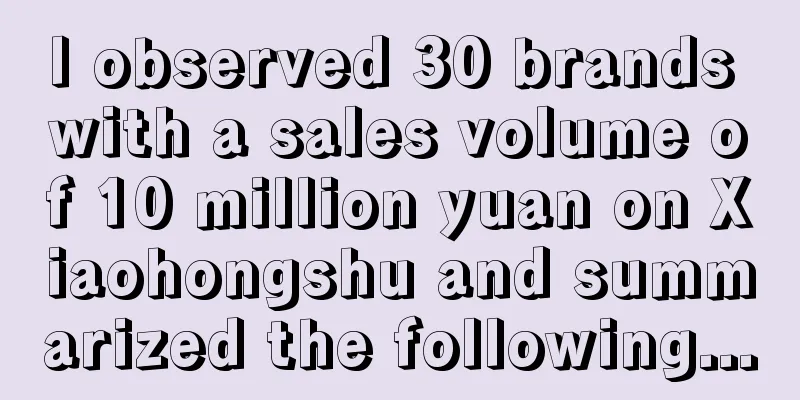We are unwilling to accept the substitution and are ridiculed for the price increase. How should domestic products be priced appropriately?

Looking back at the past year, prices have become a window to see changes in the consumer industry and changes in individual consumer concepts. Luckin Coffee’s 9.9 price war, the price per gram of domestic cosmetics is more expensive than gold, Hema launched the "Mountain Moving Price", new energy vehicle companies cut prices, and Pinduoduo, which has a low-price moat, has a market value that exceeds Alibaba... From the end of the year to the end of the year, from fast-moving consumer goods, durable consumer goods to platforms, low prices seem to have become the life-saving straw for performance. The main reason for the "price war" is that consumers are tightening their wallets, especially the middle class who supported the consumption upgrade a few years ago. In August last year, Boston Consulting pointed out in a consumer research report that the consumption attitude of domestic middle-class consumers after the epidemic has generally tended to be stable and rational, which is reflected in the following four aspects:
To sum it up in plain words, it is "you can buy expensive things, but not too expensive." The scale of value in consumers' minds is changing. A person may open Pinduoduo to be thrifty when buying daily necessities, but is willing to spend a lot of money on concert tickets. The coexistence of ice and fire in the consumer market before the epidemic is becoming more and more obvious. In the past discussions around the 4P theory, the P about price was the least discussed, but in fact it directly affects the profit level of the enterprise. Only with enough profits can brands have more development opportunities and give back to the supply chain and employees. However, in the face of consumer stratification, Chinese brands seem to always be accustomed to going for low prices and dare not challenge the high price range. Is the low price range the only choice for Chinese brands? Under the polarization of consumption, does China's consumer goods industry have the opportunity to produce more high-end brands? 1. How can domestic products become expensive?Last November, Lin Qingxuan launched the Camellia Addiction perfume, priced at 1,700 yuan, which immediately sparked widespread discussion due to its high price. After being temporarily removed from the shelves, the new price of this perfume has stabilized at 1,498 yuan. More than two months have passed, and only 4 units have been sold in the Tmall official flagship store. This sales volume is consistent with the attitude of most consumers when the topic fermented - "It's not that domestic products can't be expensive, but there must be a reason for the high price." Chinese consumers are not unwilling to pay a high premium for Chinese brands. In 2023, Wenxian, which was founded only three years ago, dared to set the price of 30ML of concentrated perfume at 1,900 yuan when it released its fourth-quarter products, and there are still consumers willing to pay for it. According to the data released by the brand earlier, in 2021, the first store in Huaihai Road, Shanghai, opened for half a year, and the average customer price reached 1,500 yuan, the store conversion rate was 30%, and the repurchase rate was 20%. 80% of the consumers of this store are born after 1995, mostly designers, artists or bloggers. Leigh Caldwell, founder of Inon, a top pricing consultancy in the UK, pointed out in his book The Price Game that when setting prices, brands need to consider two core issues: one is the pricing method, and the other is how to communicate with consumers. Leigh Caldwell shared a classic pricing method - "Pricing is positioning". The price should be determined based on the value of the product in the minds of consumers, rather than the cost of producing the product. The market positioning of the product largely affects how much consumers are willing to pay for it. Wen Xian is a typical example. In a media interview, Meng Zhaoran once shared his views on pricing. His early experience working at Gentle Monster made him realize that to build a high-end brand, "the core is whether the founder dares to think." In his opinion, many Chinese perfume and fragrance brands in the past were relatively conservative in track selection and pricing, mainly because they did not believe that the market could accept high-priced perfume brands created by Chinese people themselves. Gentle Monster’s recent AI-exclusive college card campaign has attracted a large number of young consumers to participate. When Meng Zhaoran saw the gap in the high-end perfume market, he decided to create a perfume brand for young, perfume-savvy, high-spending people, and create a unique "CHANKU" style to meet the core customer base's demand for niche styles. In the book, Leigh Caldwell also mentioned some common points behind successful high-end pricing strategies, among which higher product value is a prerequisite. Wenxian maintains cooperation with flavor and fragrance companies Givaudan and Firmenich. The cooperation mode is not only OEM, but also research and create together to obtain exclusive copyrights. Wenxian is also quite generous in the budget allocated to perfumers, and sometimes there is no upper limit. After solving the problem of how to set the price, the next question is how to communicate the price to consumers. The Perfume Book, produced and published by the French NEZ team, states that "Perfume is art, and everyone should have the opportunity to access all forms of art: painting, music, literature and perfume." After thousands of years of evolution, perfume is not only a functional product, but also a way for people who wear perfume to express themselves. Therefore, brand content carries brand premium. From graphic design, product concept to store design, employee training, offline activities... Wenxian has spent a lot of energy and budget on all content touchpoints, and spared no effort to tell consumers why my brand is worth the price you pay. On the other hand, Lin Qingxuan's obsession with camellia did not provide a good answer to these two key questions about pricing, so it is not difficult to understand why it caused controversy. 2. Chinese brands with rising volume and price: MINISO and KELASDo Chinese brands have no chance to move up from the low price range? The answer is no. According to our observation, there have been many Chinese brands that have increased both price and quantity in the past two years. They all have one thing in common: they are not afraid to set high prices and at the same time make sure that consumers are willing to pay for them. MINISO appeared in the eyes of consumers as an upgraded version of the street-side "10-yuan store". It targets the psychology of mass consumers who pursue cost-effectiveness when purchasing daily necessities, makes full use of China's supply chain advantages, and positions its products as "three highs and three lows" (high attractiveness, high quality, high frequency and low cost, low market, and low price). In the early days, it mainly relied on the cost-leading strategy to achieve rapid growth and successfully established a brand association of "value for money" in the minds of consumers. But founder Ye Guofu believes that MINISO cannot survive solely on cost advantages. In 2023, on the occasion of its tenth anniversary, MINISO proposed to become a global brand and update its brand positioning to "a global value retailer featuring IP design and providing lifestyle products." From "10-yuan store" to "lifestyle," the brand upgrades and the price also upgrades. But in the minds of consumers, it is still the representative of "value." How did MINISO do it? The answer is IP. We mentioned at the beginning that the scales for measuring value in consumers' minds have changed. They are careful with their budgets when buying daily necessities, but often pay a premium for their favorites and interests. Take MINISO's Times Square store in New York in May last year as an example. The Panda Roll blind box, which is priced at 59 yuan in China, can be sold for 19.99 US dollars in the United States. On the opening day, American consumers lined up in long queues, and what attracted them were also blind box products priced in the range of 15 to 20 US dollars. Driven by IP, the Times Square store in New York also created a single-day sales of more than 550,000 yuan for MINISO. In Ye Guofu's view, there are three key points to achieving MINISO's new goal: using product design to resonate with young consumers, using IP as a feature to make lifestyle products more fashionable, and providing creative, high-quality products to global consumers at reasonable prices. Leigh Caldwell pointed out the seven principles of pricing in "The Price Game", which mentioned that "if you want to adjust the price, you must adjust the structure of the service or product." By repositioning its brand and products, MINISO has successfully moved up to a higher price range. In fact, UNIQLO also adopts the same strategy, using new fabric technologies such as UT, designer collaborations, and airism to create a contrast between high quality and low price, raising prices while also increasing brand potential, achieving advancement in sales, prices, and brand awareness. Another example is Kaleishi. In the just-passed Double 11, jackets were undoubtedly the hottest item on the entire network. Among a number of overseas outdoor brands, the domestic brand Kaleishi broke through with the MONT series of Chinese hardshell jackets with a unit price of about 2,600-4,600 yuan per piece. Founder Zhong Chengzhan once revealed in an interview that the flagship product hardshell jacket brought the company sales of more than 100 million yuan in 2023, and even lost at least 50,000 to 100,000 pieces of business due to insufficient production capacity. Before 2019, Zhong Chengzhan had fallen into serious self-doubt due to business problems. This domestic brand founded in Guangzhou in 2003 has undergone four product upgrades, from imitating overseas big brands to winning 29 invention patents for climbing products, becoming one of the world's three largest full-line climbing brands and the only brand in Asia with a full set of 8000M+ extreme climbing products. Even such a brand, Kalen Stone, once dared not sell at full price. In a media interview, Zhong Chengzhan mentioned, "In the past, we did not dare to sell products at full price. Whether it was direct sales or dealers, we had no confidence. Why would a domestic brand dare to sell at full price? Now we force him, especially Mr. Kong (Kong Fanyong, General Manager of Kalen Stone Business Unit), to sell high-performance products at full price." How did Kalas do it? First of all, it started with adjusting its product line. In the past, Kalas' products were mainly aimed at two groups of people: one was the core professional group that would go hiking, and the other was the general public. The first group was too small to support most of the business; the second group did not invest too much time and money in outdoor sports. As outdoor sports continued to heat up, the new outdoor group began to grow. They regarded outdoor sports as a hobby and had requirements for both design and performance. There were not many brands on the market that could meet their needs. Since 2019, Kalas has started to adjust its product line, cutting off "cheap goods" and focusing on high-performance products, targeting this group of incremental people to do business. It has also made adjustments in channels, canceling the operating qualifications of nearly half of the dealers who set random prices. Last year, it signed a contract with Topsports, the largest sports footwear and apparel retailer in China, to cooperate in community, store operations and consumer operations. Zhong Chengzhan said that the profits from high-performance products will be used to export brand value and continue to invest in research and development. In October this year, Kalas launched the "First Snow Mountain in Life" event, holding a snow mountain film festival, mountain film viewing, and high-altitude climbing music festival in Siguniang Mountain, and invited professional athletes to share their experience and feelings of climbing snow mountains. At the same time, Kalas released the MONT X hardshell jacket inspired by the three Chinese snow mountains of Yaomeifeng, Gongga Snow Mountain, and Sap Snow Mountain. "If the dream of climbing has a color, it is the color of Chinese mountains." However, Zhong Chengzhan, who has been working hard on the product, still has not found a satisfactory Kalenji product. In an interview, he mentioned, "If we want to make a satisfactory product, we must look at the price, control the cost, and let the dealers make a profit. There are satisfactory products in other brands, but they don't care about the cost, sell it for 5,000 yuan, and use whatever materials they want. We are entangled and uncomfortable. Now that the product structure has been adjusted, the price has become higher and the profit has increased, we can also make high performance." 3. Analyst CommentsChinese people are very good at price manipulation. Under the trend of polarization, it seems that the most common choice we see is to reduce the price to a low level, leaving the high price range, and not daring to challenge. In fact, don't be afraid to set a high price, but make sure that consumers are willing to pay for it. Wenxian, Miniso, Kalas... We see more and more Chinese brands finding gaps in the market and adjusting their products and services to meet the needs of the new population. Despite facing challenges from the industry and doubts from the market in this process, they are still firmly on this more difficult road. High pricing requires brands to balance value and cost. In addition to the high value of the core product itself, they also need to provide customers with other added value related to the product, such as Wenxian's unique style and well-crafted content, and Kailas' Unreached Summit Project, Rock Hunting China, and coach training projects for the development of China's mountaineering, rock climbing, and trail running culture. In the European and American cultural highlands such as perfume and outdoor activities, can Chinese brands explore a potential path of their own? We are willing to believe that the answer is yes. Author: disturb WeChat public account: Knife Skills Research Institute (ID: DigipontClub) |
<<: Non-standard product business in private domain
>>: How to Go Crazy in Brand Marketing in 2024
Recommend
The Making of a “Roll King” in the New Tea Beverage Industry
This article mainly describes the competitive situ...
Does Shopee not require a business license? What are the advantages?
In recent years, the cross-border e-commerce indus...
Stop copying books, this is how to do user life cycle analysis
Many students are troubled by questions such as &q...
Do I need a business license to open a Shopee store? What are the conditions?
Nowadays, if many individuals want to engage in cr...
Video account e-commerce, "grasping" the middle-aged and elderly
With the attributes of WeChat private domain traff...
DHgate.com launches new product growth center
In order to enhance the buyer experience, increase...
Xiaohongshu buyers have always been on the opposite side of the merchants
In the Xiaohongshu e-commerce live streaming secti...
E-commerce platforms have launched "automatic price tracking" one after another, forcing hundreds of millions of merchants to hurry up
During this particularly difficult 618, merchants ...
Since all the big Vs are crossing circles, is there still a chance to "win" professional automotive vertical accounts?
This article is about the trend and prospect analy...
Why did Pinduoduo’s methodology fail?
As e-commerce competition becomes increasingly fie...
How can Haidilao, which has “changed its heart”, ask for “change”?
The author of this article introduces the fact tha...
How to change Amazon FBA model to FBM? How to do it well?
Merchants who open stores on Amazon will first cho...
Where is Lazada's local store suitable for opening? What are the advantages?
There are many merchants doing cross-border e-comm...
What is the tutorial for Shopee merchants to upload products? Tutorial sharing
Shopee is a relatively easy-to-use platform in cro...
Why do I need a domestic bank card to register on Amazon? Detailed answer
If you want to join Amazon, you must first registe...









